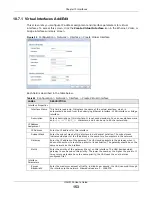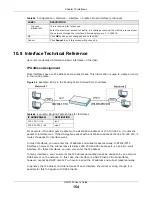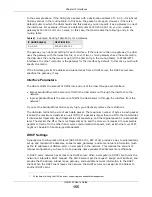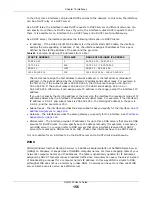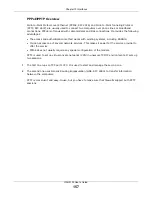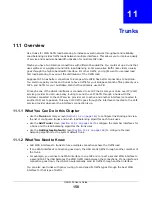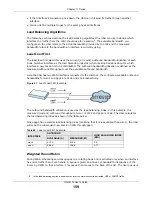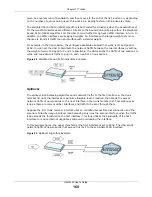
Chapter 12 Policy and Static Routes
UAG5100 User’s Guide
167
Policy-based routing is applied to incoming packets on a per interface basis, prior to the normal
routing.
How You Can Use Policy Routing
• Source-Based Routing – Network administrators can use policy-based routing to direct traffic
from different users through different connections.
• Cost Savings – IPPR allows organizations to distribute interactive traffic on high-bandwidth, high-
cost paths while using low-cost paths for batch traffic.
• Load Sharing – Network administrators can use IPPR to distribute traffic among multiple paths.
• NAT - The UAG performs NAT by default for traffic going to or from the WAN interfaces. A routing
policy’s SNAT allows network administrators to have traffic received on a specified interface use a
specified IP address as the source IP address.
Note: The UAG automatically uses SNAT for traffic it routes from internal interfaces to
external interfaces. For example LAN to WAN traffic.
Static Routes
The UAG usually uses the default gateway to route outbound traffic from computers on the LAN to
the Internet. To have the UAG send data to devices not reachable through the default gateway, use
static routes.
Policy Routes Versus Static Routes
• Policy routes are more flexible than static routes. You can select more criteria for the traffic to
match and can also use schedules, and NAT.
• Policy routes are only used within the UAG itself.
• Policy routes take priority over static routes. If you need to use a routing policy on the UAG and
propagate it to other routers, you could configure a policy route and an equivalent static route.
DiffServ
QoS is used to prioritize source-to-destination traffic flows. All packets in the same flow are given
the same priority. CoS (class of service) is a way of managing traffic in a network by grouping
similar types of traffic together and treating each type as a class. You can use CoS to give different
priorities to different packet types.
DiffServ (Differentiated Services) is a class of service (CoS) model that marks packets so that they
receive specific per-hop treatment at DiffServ-compliant network devices along the route based on
the application types and traffic flow. Packets are marked with DiffServ Code Points (DSCPs)
indicating the level of service desired. This allows the intermediary DiffServ-compliant network
devices to handle the packets differently depending on the code points without the need to
negotiate paths or remember state information for every flow. In addition, applications do not have
to request a particular service or give advanced notice of where the traffic is going.

